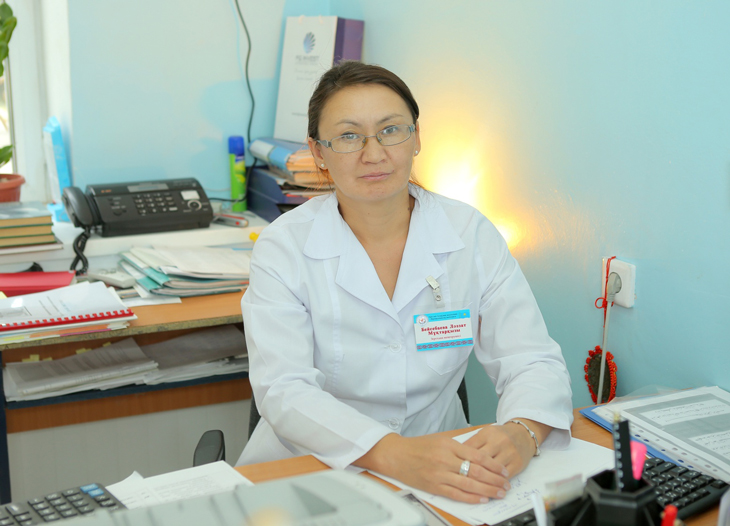«South clinical & Genetic laboratory» JSC SKMA

Head of the laboratory
Lyazzat Mukhtarovna Beisebaeva
The South clinical & Genetic laboratory was created by order of the rector of JSC SKMA No. 18 dated 03/11/2021 by merging the Research Laboratory for Genomic Research and the Clinical Diagnostic Laboratory.
The total area of laboratories is 576.3 square meters, located in the left wing of the first floor of the main building of the SKMA, there are 14 offices, three entrances and exits (main, spare and for patients from the street side).
A mixed lighting system operates in the laboratory: natural - due to window openings, artificial - due to ceiling fluorescent lamps, and local lighting with the formation of a luminous flux at the workplace.
The laboratory is equipped with a mixed ventilation system: autonomous exhaust fans and safety hoods. Water supply is centralized, sewerage is central, and heating is central. Laboratory conditions coincides with international standards.
All available laboratories are dedicated to scientific and clinical research. The Laboratory has a number of profiled subdivisions: biochemical, hematological, clinical, ELISA and PCR diagnostics, cytogenetics.
The laboratory has the necessary infrastructure to implement a full cycle of research. The laboratory received a license to carry out laboratory activities No. 0012397ДХ from 01/13/2013, and in 2018 - 06.04. No. 0111250DX updated due to the change in the status of the academy.
Further development of the laboratory will be carried out in stages. At the initial stage, it is planned to determine the range of services provided - laboratory diagnostics for the population (general clinical, serological, enzyme-linked immunosorbent assays, polymerase chain reaction), and government orders. At the further stage of development, in accordance with the peculiarities of the methods and the specifics of practical and scientific tasks, the laboratory organizes the main areas of laboratory activity: biochemical, cytogenetic and molecular genetic research, as one of the priority scientific areas.
Polymerase chain reaction (PCR)
By now, various genetic testing systems have been developed and are widely used, the total number of which is close to one hundred.
The overwhelming majority of such systems are based on polymerase chain reaction (PCR), which makes it possible to achieve a significant increase in low concentrations of certain (interesting) DNA fragments. Typically, after or during PCR, various methods are used to detect genomic changes.

Determination of a polymorphic site using the RFLP method is one of the most common methods for detecting SNP (single nucleotide substitutions)

Biological microchip technology
Unlike most approaches, this technology makes it possible to use relatively small amounts of starting material, carry out a reaction in microvolumes, and simultaneously carry out a multivariate analysis of many genes of the same object.

Real-time PCR (or quantitative PCR, English Real-time PCR, qPCR, qRT-PCR) is a laboratory method based on the polymerase chain reaction method.

Digital PCR (dPCR) is an improved method of traditional real-time PCR that allows direct counting of the number of targets - nucleic acids.

Capillary electrophoresis is the gold standard for DNA sequencing.
DNA sequencing (determination of the primary nucleotide sequence) today serves as the main tool for fundamental, applied and clinical research.

Solexa technology, which includes bridge-PCR on a flow-through chip, synthetic sequencing (SBS) using fluorescently labeled nucleotides, and detection of fluorescence light from DNA clusters.
An enzyme-linked immunosorbent assay (ELISA) is one of the methods of laboratory diagnostics, which is based on a reaction called "antigen-antibody".
The production of antibodies is provoked by the antigens themselves, which have penetrated the human body. When entering the "battle" for the health of the body, antibodies seem to mark the antigens, which is what the laboratory assistant sees when examining the blood. That is, in the collected biomaterial, it is possible to track not only the presence of infection, but also its traces after the body has completely recovered.
When conducting an ELISA test, a doctor of clinical laboratory diagnostics can see the following immunoglobulins to antigens:
• Immunoglobulins M (listed as IgM in the results). They indicate that the infectious process in the body is only gaining its strength. That is, the infection happened quite recently;
• Immunoglobulins G (listed as IgG). Contribute to the destruction of antigens a few days after the introduction of the infection into the human body. Immunoglobulins G can be in the patient's body for a long time, forming immunity to a specific pathogen;
• Immunoglobulins E (listed as IgE). Indicate parasitic infections in the body. He also talks about atopic reactions in allergies.
Laboratory staff:
1. Head of Laboratory - L.M. Beisebaeva
2. Leading Researcher - A.A. Burabaev
3. Leading researcher - B.Zh. Kulbaeva
4. researcher - D.T. Azhibaeva-Kupenova
5. Researcher - A.M. Duissenova
6. junior researcher - A.A. Burabaev
7. laboratory specialist-Usenbek D.U.
8. senior laboratory assistant - Seissenbaeva S.A.
9. nurse - D.B. Tursunbayeva
10. cleaner - B.B. Umishova
Contact Information:
Shymkent, pl. Al-Farabi 1, main building, 1st floor, left wing, office "Assistant-2"
Tel: 8(7252) 51-46-98
e-mail: lyzzatb70@list.ru
cell phone number: 87012388338
 497 views
497 views
